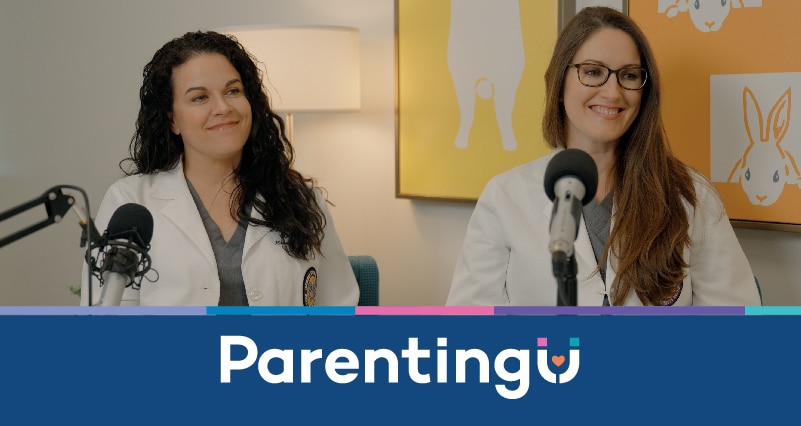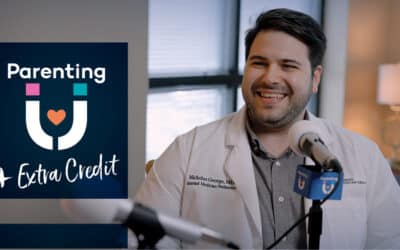Cleft lip and cleft palate are quite common, with one in 700 kids nationwide having such a diagnosis. Thanks to early-in-life repairs, most are only left with a thin, fine scar.
Co-directors of Our Lady of the Lake Children’s Health Cleft and Craniofacial Multidisciplinary Team, Lisa Morris, MD, and Laura Hetzler, MD, FACS, share what parents need to know and what to expect if their child has a cleft lip and/or palate in this ParentingU podcast episode.
Understanding Cleft Lip and Palate
A cleft lip or palate happens very early in pregnancy, when the face is forming in utero and doesn’t complete its full development. Babies can have a cleft lip with or without a cleft palate or can have only a cleft palate. Usually there’s no identifiable reason why. It is often found during a 20-week ultrasound.
A cleft lip is a gap from the nose down to the mouth’s opening. A cleft palate splits the roof of the mouth, which is two parts – a hard palate that’s bone and a soft palate that’s muscle helping with speech and ears – ending in the back of the throat with the uvula, which can also develop in two.
First Steps After Diagnosis
After a family knows their baby will have a cleft lip and/or palate, prenatal visits with our team are an important way to get armed with knowledge. It’s also easier for parents to hear and absorb information before having a baby in their arms.
This type of diagnosis is not a reason to panic. Usually kids can get the cleft repaired and then have a typical childhood.
Collaborative Care, Team Approach
Accredited by the American Cleft Palate-Craniofacial Association, our cleft and craniofacial multidisciplinary team follows a child before birth through childhood to adulthood and even further if need be. Patients come from across the Gulf coast.
Our team includes:
- Facial plastic and reconstructive surgeons, Dr. Hetzler and Dr. Morris, to do the repairs, and a neurosurgeon if there are other craniofacial anomalies
- Speech language pathologist to help with feeding and speech
- Audiologists to monitor hearing
- Pediatric dentists and orthodontists, since a cleft palate impacts the jaw and teeth
- Geneticist to investigate the cause, if there are risks if the parents have other children and if the child has children later in life
- Pediatrician to care for all the child’s other health and development needs
- Social worker who ties everything together, connecting families with resources
Feeding Concerns
A baby with a cleft palate will have a hard time nursing because the cleft impacts suction, like trying to drink from a straw with holes in it. Special bottles allow babies to get nutrition and thrive.
Moms who want to breastfeed would need to pump to maintain milk supply, although a baby with a cleft lip only should be able to nurse with a little help of manual pressure or tape to keep the lips closed during feeding.
Babies find a way to eat, and feeding is usually figured out in the first week of life and then baby thrives.
Surgical Repairs Creating Smiles
Surgery can correct the abnormalities in a cleft lip and/or palate, but the timing depends on what’s affected and the individual patient.
The most common type is a complete cleft lip and palate, skin, muscle, gumline and palate with one side completely open. This requires multiple surgeries because of children’s growth, but the typical timeline may include:
- Close the cleft lip early, around 2 to 3 months.
- Palate repair somewhere between 10 and 12 months, no later than 18 months to have it put back together before speech begins.
- Not every child will need it, but sometimes a palate repair to improve speech and air leaking out of nose happens between ages 4 and 6.
- If the cleft includes the gumline, a bone graft happens between ages 7 and 12 just before adult teeth are coming in. Bone from the hip is used to fill in the gumline and the tooth will erupt into the grafted bone.
- Orthognathic or jaw surgery is sometimes needed if the upper jaw doesn’t grow properly. Not everyone with a cleft lip or palate will need such a surgery, but having a cleft is a higher risk of needing it.
- The final surgery is a septorhinoplasty, or nose job, to repair a crooked septum and make it easier to breathe. This is only considered after growth is complete and any other surgeries
Our system of coordinated care ensures comprehensive, individualized care for each patient and their family.




